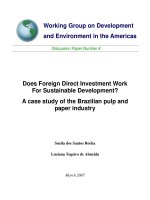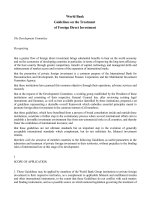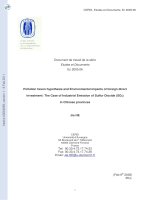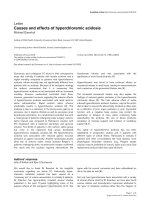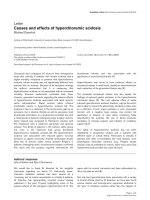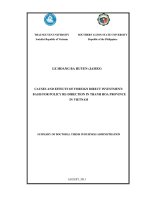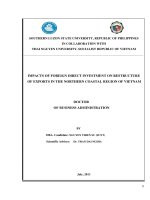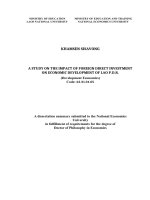CAUSES AND EFFECTS OF FOREIGN DIRECT INVESTMENT BASIS FOR POLICY REDIRECTION IN THANH HOA PROVINCE IN VIETNAM
Bạn đang xem bản rút gọn của tài liệu. Xem và tải ngay bản đầy đủ của tài liệu tại đây (300.1 KB, 27 trang )
THAI NGUYEN UNIVERSITY
Socialist Republic of Vietnam
SOUTHERN LUZON STATE UNIVERSITY
Republic of the Philippines
LE HOANG BA HUYEN (JAMES)
CAUSES AND EFFECTS OF FOREIGN DIRECT INVESTMENT:
BASIS FOR POLICY RE-DIRECTION IN THANH HOA PROVINCE
IN VIETNAM
SUMMARY OF DOCTORAL THESIS IN BUSINESS ADMINISTRATION
AUGUST, 2013
0
LIST OF AUTHOR’S PUBLISHED STUDY
1. Le Hoang Ba Huyen, “Mobilizing investment for socio – economic development
in the western Thanh Hoa”, Journal of Economic & Development, National Economics
University, No. 5 of 2009, pp. 44-46.
2. Le Hoang Ba Huyen, “Proposes some major solutions to enhance the rate of
progress to draw the balance sheet on construction and investment for 135 projects in
Ba Thuoc District”, Journal of Finance & Business Administration No. 11 of 2009,
pp. 22-26.
3. Le Hoang Ba Huyen, “To perfect the management of state budget expenses on
construction and investment for 135 project in Ba Thuoc District”, Journal of Science,
Hong Duc University No. 4 of 2010, pp. 96-102.
4. Le Hoang Ba Huyen, “Developing cultural – ecological tourism in Pu Luong nature
reserving zone in Thanh Hoa province”, Journal of Science, Hong Duc University
No. 7 of 2011, pp. 114-119.
5. Le Hoang Ba Huyen, Le Quang Huy, “Some suggestion to financial management
of 30a program in Ba Thuoc district, Thanh Hoa province”, Journal of Economic &
Development, National Economics University, No. 182(II) of 2012, pp. 38-44.
6. Le Hoang Ba Huyen, Nguyen Thi Thanh Xuan, “Some solutions to attract foreign
direct investment (FDI) in Thanh Hoa province”, Science and Technology Journal of
Agriculture & Rural Development, Ministry of Agriculture and Rural Development,
Vietnam, No. 9/2012, pp. 160-165.
7. Le Hoang Ba Huyen, Nguyen Thi Thu Phuong, Nguyen Thu Huong, “Analyzing
the factors affecting the investment of FDI companies in Thanh Hoa province”,
Journal of Economic & Development, National Economics University, No. 188(II) of
2013, pp. 76-81.
8. Nguyen Thi Thu Phuong, Le Hoang Ba Huyen, Nguyen Thu Huong, “Enhancing
the role of internal auditing in preventing risks of foreign direct investment in Thanh
Hoa province”, Socio – Economic information and Forecast Journal, Ministry of
Planning and Investment, No.87 – March 2013. pp 33 – 37.
9. Le Hoang Ba Huyen, Tran Dai Nghia, “Identification of the main factors affecting
the attraction of foreign direct investment into Thanh Hoa province”, Journal of
Economic & Development, National Economics University, No. 190(II) of 2013, pp. 34-
39.
1
CHAPTER 1
INTRODUCTION
1.1 Problem Statement
According to the decentralization policy started in the FDI
law
amendment in 1996, each province was decentralized with more power and
autonomy in dealing
with
foreign investments such as in granting investment
licenses, leasing
land,
providing export and import licenses and recruiting labor.
This policy, on the
one
hand, allows provincial authorities to develop in an
innovative ways that attract
more
foreign investors, and also leads to variations
in
the
implementation of the central laws and regulations among provinces.
Foreign
investors may experience a lot of red tapes namely, corruption or delays
in
administrative progress if local authorities possess conservative inherited
norms
and cognitions. In this context, foreign investors have considered many
factors
when investing in Vietnam such as modes of entry and location choices for
their
operations so that they can make use of advantages and minimize
disadvantages.
In order to attract investors to Thanh Hoa and give the most favorable
conditions to them, the province has offered many investment priority policies as well
as improves administrative procedures. Over the past revised, the province’s
investment environment has been significantly improved. With a view to: no
restrictions on size, industry, and geographic areas, based on the Investment Law and
Enterprise Law, Thanh Hoa is continuing to review and to improve the system of
mechanisms and policies towards incentives and making it more convenient for
investors. These mechanisms and policies of Thanh Hoa focus on improve and
simplify administrative procedures, issue the open and attractive mechanisms and
policies, call for investment, create innovative in building essential socio-economic
infrastructure, promote the advantages of human resources, improve the quality of
human resources in order to meet business’s demands. In addition, resolution No
02/NQ-TU dated 27/6/2011 regarding improvement for investment environment in
province in the stage 2011 – 2015 focused on implementing site clearance work in
order to meet investors’ requirements, support business development, transparency of
information for business, support business development, transparency of information
for business. With the above policy should take until 2012 in Thanh Hoa province has
2
41 investment projects involving foreign direct operation with a total registered
capital of USD 6,952 million.
These results are encouraging, but compared to the potential and advantages of
Thanh Hoa province are still limited. The number and sizes of investment projects in
Thanh Hoa are low. Thanh Hoa is not one of the top provinces classified based on
provincial competitiveness index. We have to describe the trends in FDI in Thanh
Hoa Province and identified of factors affecting the attraction of foreign investment in
Thanh Hoa. After that we can analysis of the impact of each factor to attract foreign
investment is essential for the government in offering policies to attract investment
capital and analyze the effects of FDI in the economic growth of Thanh Hoa Province.
Therefore, we can formulate policy implication to enhance economic growth of Thanh
Hoa Province in Vietnam.
This thesis focuses on determinant of “Causes and Effects of Foreign Direct
Investment: Basis for Policy Redirection in Thanh Hoa in Vietnam”.
1.2 Research Objectives
The main objective of this research is to determinants Foreign Direct
investment in Thanh Hoa province. Thus it hopes to achieve the following objectives:
1. To describe the trends in FDI in Thanh Hoa Province in the period from
2001 to 2012.
2. To determine the factors affecting attraction of FDI in Thanh Hoa Province
in terms of the following factors: Political and legal; Social and culture; Financial;
Economic and marketing; Availability of resources and Infrastructure requirement
3. To analyze the effects of FDI in the economic growth of Thanh Hoa
Province.
4. To formulate policy implication to enhance economic growth of Thanh Hoa
Province in Vietnam.
1.3 Study Object and Scope
1.3.1. Object:
Causes and Effects of Foreign Direct Investment in locality.
1.3.2. Scope
+ Spatial limitation Study site: Thanh Hoa province. Field survey was
conducted in forty one (41) FDI entrepreneurs and 200 officers.
+ Time range
- Secondary data: collected during the period 2001 - 2012;
3
- Primary data: Surveys were conducted in the period 2012 - 2013;
- The solution was studied and proposed up to 2020.
13.3. Limits on Content
- Studying the trends in FDI in Thanh Hoa province;
- Determinant factors affecting FDI flow to Thanh Hoa province;
- Analyzing the effects of FDI in the economic growth of Thanh Hoa Province.
1.4 Research Questions
In order to achieve the above objectives, the following research questions were
proposed for this study:
1. What are the existing conditions of industry facilities of Thanh Hoa Province
2. What are the existing policies with regards to (Ownership sharing; Stocks
distribution & allocation; Permits and Registration; Taxation; Supply of raw
materials; Capitalization & other resource; Man power)
3. To what extent that foreign direct investment is affected as course the low
FDI.
4. Is there a significant difference on the perceptions of respondents in terms of
factors affecting the process of FDI investment in the Thanh Hoa province?
5. What policies investors & incentives can be redirected to encourage and
improve performance of FDI?
1.5 Significance of the Study
(1). The thesis indicated the general picture of foreign direct investment in Thanh Hoa
province in the period from 2001 to 2012. At the same time, it also pointed out the
trend of foreign direct investment in Thanh Hoa province during this period through
the number of projects, the registered capital and the field of investment projects.
(2). The thesis is one of the first studies implemented in the province of Thanh Hoa
about the factors affecting attraction of FDI in the province. This thesis has built
models of group factors affecting attraction of FDI in Thanh Hoa Province. Based on
surveys of foreign investors and the use of statistical analysis software, author
assessed the importance of each factor and group factors in attraction of foreign direct
investment into this province.
(3). The thesis also assessed and summarized the impact of foreign direct investment
for each field as raising capital for development investment, job creation, and
contribution to exports in particular and to the growth and economic transformation in
general.
4
(4). The thesis interpreted the causes affecting the process of implementation FDI
projects in Thanh Hoa province. It also assessed the impacts of these factors on the
implementation of investment projects of foreign enterprises under the view of
foreign investors and of the local government related to this activity. Moreover, the
thesis analyzed and interpreted of the causes of that situation.
(5). The author proposed seven groups of solutions in attracting foreign direct
investment into the province of Thanh Hoa and promoting the role of FDI projects in
contributing to the growth and restructuring the local economy.
CHAPTER 2
LITERATURE REVIEW AND STUDIES
2.1. Theoretical overview: FDI
2.1.1 Definitions of FDI
FDI can be understood as investment activities of economic organizations,
individuals in a country by themselves or co-operate with other economic
organizations and individuals in another nation to invest money and assets under a
certain investment form. They take responsibilities wholly or partially in direct
management and administration production and business activities and also business
results basing on the rate of control right and of capital ownership.
2.1.2 Attract FDI
- Attract FDI is the activity to agitate foreign investors investing in a nation or
a regio/ province of the nation.
- The attraction has to include lot of measures, proper steps and also
participations of many entities from individuals, organizations, companies, local
government and central government.
- Attracting FDI might be under active and passive forms.
2.1.3 Forms of FDI
According to the Investment Law of Vietnam (2005), the forms of FDI
include:
+ Companies with 100% investment capital from foreign investors.
+ Joint – venture
+ Business co-operation under forms of BCC, BOT, BTO, BT, PPP
2.1.4 Effects of FDI
5
FDI affects the economy under following aspects:
- FDI provides capital to increase budget
- Effects of FDI on economic growth
- FDI and technology
2.1.5 Summary of some theories of attraction of FDI
2.1.5.1. Theory of marginal benefits
2.1.5.2. Theory of market power
2.1.5.3 Theory of Ownership advantages – Location advantages –
Internalizations advantages
2.1.5.4. Theory of steps for investment development
2.2 FDI and Motivation
2.3 Factors Influencing Location of FDI
2.3.1 Political stability and policy mechanisms factors
- Stability of politics
- Policy mechanisms
2.3.2 Socio-cultural environment factors
2.3.3 Financial factors
2.3.4 Economy and market factors
- Market factor
- Profit factor
- Cost Factor
2.3.5 Resource factors
- Human resources
- Natural Resources
2.3.6 Infrastructure factors
2.4 The determinants of the FDI in Vietnam review of
literature
The contents of the research fields mentioned are controversial. This is
because the process of Globalization and the integration of international economy
have been widely affecting to the entire nations’ economy and many issues have been
being considered differently. These researches are based on the sense of initiative of
host countries, and the orientation of the development of economy – society in nation
extent only, rarely mentioned local extent. Up to now, there is no research that
mentioned sufficiently and systematically about the issues like: determining the
factors that affect the attracting FDI into Thanh Hoa. Based on it, the researcher can
6
give the policies solutions for Thanh Hoa in particular and for Vietnam in general.
Hence, the thesis contributes the usage of theoretical basis to solve the important real
issues of the FDI for Thanh Hoa province.
2.5 The mechanisms and policies for attracting FDI in Thanh Hoa province
- The policies that encourage the development of small industries and
businesses in the province of Thanh Hoa (Decision No. 2541/2008/QD-UBND on
08.19.2008);
- Support to share the costs of the construction of markets, supermarkets,
commercial centers (defined in Decision No. 4670 / 2010/QD-UBND on 27/12/2010)
- Policies of providing support production, export business (defined in
Decision 2545/2009/QD-UBND on 08.06.2009);
- Mechanisms and policies were established to encourage the development of
non-public establishments operating in the fields of education, vocational training,
health care, culture, sports, environment (defined in Decision 4294/2011/QD -2011);
- Policy supports investments in Nghi Son economic zone and industrial parks
(currently under construction);
CHAPTER 3
RESEARCH METHODOLOGY
3.1.
Theoretical framework
and hypothesis development
This study will be conducted based on the theoretical frame work drawn from
eclectic paradigm or the “OLI” paradigm develop by “Dunning” as explain under the
literature review and studies and according to factors which are influencing to choice
of a host market of Gilomre, O’s Donnel, Carson and Cummins (2003). The following
factors are considered as maininfluences for attracting FDI to Thanh Hoa province.
(1) Political, government and legal factors such as political stability,
government tax incentives, province image and the institutional performance by
provincial
authorities.
(2) Social and cultural factors such as level of education, attitudes,
b e l i e f s and values, religion, manners and customs, language and communication.
(3) Economic and market factors, such as
economic growth, domestic
investment affect; diversified industrial base, infrastructure; the size of the
local
market;
and
market growth.
7
(4) Financial factors such as interest rate, inflation, exchange rate, currency
risk, agglomeration effect
in
attracting FDI.
(5) Availability of resources factors such as terrain /topography, natural
resources, raw materials, large population size, quality of labor force, low cost skill
and unskilled, labor human and development labor.
( 6 ) Infrastructure factors such as communication infrastructure,
accessibility, physical infrastructure (roads, sea and air ports, railways,
telecommunication systems and institutional development such as legal services,
accounting etc), level of technology development, low transport and logistic costs,
Figure 3.1 Theoretical Framework
3.2. Sample size and Population determination
3.2.1 Population determination
- Business managers of foreign direct investments and the main shareholders
of the businesses: There are forty one (41) FDI entrepreneursoperatingin Thanh Hoa
province during period from 2001 to 2012.
- Government officials: The population of this study is 100 officers who are in
Province people’s committees, Department of Planning and Investment, Department of
Finance, Department of Industry, Tax Authority, Land Authority, Department of
Political, Government
and
Legal
Factors
Social and Cultural
Factors
Economic and Market
Factors
Financial Factors
Availability of resources
factors
Perceived
increase of
Foreign
Infrastructure Factors
8
Transportation, Department of Agriculture and Rural Development, Investment
promotion center of Thanh Hoa province, Branch of State Bank of Thanh Hoa, Union of
Cooperatives and Small and Medium Size Enterprises and Vietnam Chamber of
Commerce and Industry in Thanh Hoa.
3.2.2 Sample size determination
The sample size determination: the sample size is determined using the Slovin
formulation as follows:
n = N / (1 + Ne
2
)
Where
n
the sample size of each respondent group
N
total population of the respondent group
e
2
is probability of error
- Business managers of foreign direct investments and the main shareholders
of the businesses: With the population of this study are forty one (41) FDI
entrepreneurs (N = 41), e = 5% (at least 95% confidence level),
Therefore the
sample size for this study is:
n =
41/ {1 + 41 (0.05)
2
}
n = 37
Hence the sample size is 37, to collect the required data 37 questionnaires
were send to the FDI companies located in Thanh Hoa through the ways of both e -
mailing and personally. There is thirty seven (37) respondents were received.
- Government officials: With the population of this study are 100 officers (N =
100), e = 5% (at least 95% confidence level),
Therefore the sample size for this study
is:
n =
100/ {1 + 100 (0.05)
2
}
n = 80
Hence the sample size is 80, to collect the required data 80 questionnaires
were send to the Government officials in Thanh Hoa Province through the ways of
both e – mailing, telephone and personally. There are eighty (80) respondents were
received.
3.2.3 Sampling Method
9
To select the sample, the Random Sampling Method was applied as the
respondents for this research was focused base on the existing FDI entrepreneurs who
established their business in Thanh Hoa from 2001 up to 2012. As for the
investigation, interviewing staff in state agencies Thanh Hoa province, proceed as
follows: First of all authors 12 provincial agencies most relevant to foreign direct
investment in addition to in Thanh Hoa including Province people’s committees,
Department of Planning and Investment, Department of Finance, Department of
Industry, Tax Authority, Land Authority, Department of Transportation, Department
of Agriculture and Rural Development, Investment promotion center of Thanh Hoa
province … In addition, selecting the District 6 representative to mountainous areas,
coastal and plains.
3.3. Questionnaire Design
The questionnaires were designed to get uo to date for research objective with
the objectives of the study. The questionnaire comprised of three parts. The part
one was designed to ask the respondents providing the general information of
enterprises. The second part consisted of determinant factors driving selection of
Thanh Hoa province measured on the liker scale with “1” as least important and “5”
as most important. The third part consisted of affecting factors on the investment
process in Thanh Hoa province.
3.4. Response Rate
With the survey of FDI managers, thirty seven respondents responded out of
forty one sent out, hence the rate of response is 90 ,2% and it can be considered
as satisfactory level. For the investigation of the officials of the local authorities,
eighty respondents responded out of 90 sent out, hence the rate of response is
88.9%. The questionnaires were handed out to working individual and were
collected immediately after they were completed.
CHAPTER 4
DATA ANALYSIS AND RESULTS
4.1 The trends of FDI inflows in Thanh Hoa Province in the period from 2001 to
2012
The FDI inflows in Thanh Hoa increased rapidly in the period from 2001 -
2012, the invested capital, on average, was US $ 15, 09 million a year. During the
10
period from 2006 to 2011, although suffering from the world and the regional
economic crisis; high inflation rate and increasing prices of input materials in
domestic markets. The FDI in Thanh Hoa province has achieved good results.
Table 4.1: Foreign direct investment project licensed in period 2001 to 2011
Registered capital (Mill.USD)
Year
Number of
projects
Total
Of which:
Legal capital
2001 1 0,67 0,67
2002 1 0,18 0,18
2003 1 0,90 0,30
2004 3 1,97 0,52
2005 7 30,50 30,50
2006 5 6,35 6,35
2007 7 34,73 6,46
2008 8 6.188,60 222,30
2009 3 13,15 -
2010 11 81,93 -
2011 5 42,10 -
Source:
Thanh Hoa
Statistics
Office 2012
4.2 Data analysis about the factors affecting the attraction of foreign direct
investment in Thanh Hoa Province.
4.2.1 The importance of various factors in attracting FDI ìnlows in Thanh Hoa
province
4.2.1.1. Political/governmental/legal factors (F1)
The importance of this factor is reflected in analytical results represented in
Table 4.2 below:
11
Table 4.2 The importance level of political, governmental
and legal factors
Attributes
Rank
sum
P Value
Adj.
Variance
Tax or land incentives 629 0.0403** 380
Convenient procedures lease/land 591 0.8900 330
Political stability 559 0.1806 502
The legal requirements for clear and
transparent
604 0.4075 328
Expropriation risk 655 0.0020*** 455
Protection of property 592 0.8610 399
Protection of intellectual property rights 555 0.0820* 381
Security and order 585 0.08620* 408
* Statistically significant at the level of 10%
** Statistically significant at the level of 5%
*** Statistically significant at the level of 1%
The table 4.2 presents there are four factors affecting FDI inflow to Thanh
Hoa province significantly, i.e., tax or land incentives factor (with P - Value of
0.0403**), expropriation risk factor (with P - Value of 0.0020***), protection of
intellectual property rights factor (with P - Value of 0.0820*) and security and order
factor (with P - Value of 0.08620*). All variables mentioned above are rated as high
importance, specifically expropriation risk factor was ranked with highest score of
655 (rank sum of 655).
On the other hand, convenient procedures lease/land, political stability, the
legal requirements for clear and transparent, protection of property factors have
positive impacts on decision making of foreign investors in general, however, in
particular at Thanh Hoa, it shown that these factors have not statistically affected
investment decisions of foreign investors.
4.2.1.2. Social and cultural factors (F2)
In Thanh Hoa, these factors are presented in the following table:
12
Table 4.3 The importance level of social and cultural factors
Attributes Rank sum
P Value
Adj.
Variance
Attitudes, beliefs and values 594 0.788 416
Religion 582 0.730 357
Language and communication 568 0.344 493
Cultural proximity 609 0.339 438
* Statistically significant at the level of 10%
** Statistically significant at the level of 5%
*** Statistically significant at the level of 1%
It shows that investors are not statistically affected by these factors when
making their investment decision Thanh Hoa. Specifically, attitudes, beliefs and values
factors has P – Value of 0.788, religion factor has P – Value of 0.730, language and
communication factor has P – Value of 0.344 and cultural proximity factor has P –
Value of 0.339.
4.2.1.3. Financial factors (F.3)
In Thanh Hoa, investors highly appreciate the role of these factors when they
have a decision investing to this local as shown in the following table:
Table 4.4 The importance level of financial factors
Attributes Rank sum
P Value Adj. Variance
Reasonable and stable interest rate 596 0.72381 381
High inflation 596 0.7331 566
Fluctuation of exchange rate 566 0.078* 449
Access to capital 649 0.007*** 507
* Statistically significant at the level of 10%
** Statistically significant at the level of 5%
*** Statistically significant at the level of 1%
As it is shown by the table 4.4, fluctuation of exchange rate factor and access
to capital factor is the most important factors in group factors. On the other hand, the
reasonable and stable interest rate and high inflation factors are not statistically
affected by these factors when making their investment decision Thanh Hoa.
13
4.2.1.4. Economic and marketing factors (F4)
Table 4.5 The importance level of economic and marketing factors
Attributes Rank sum
P Value
Adj.
Variance
Size of domestic market 611 0.259 380
Costs of intermediate goods and service 618 0.121 351
Wealth of Vietnamese consumers 600 0.487 274
Proximity to export markets 647 0.0056*** 445
Other investors in my industry were already 612 0.155 273
The main competitors 609 0.286 351
* Statistically significant at the level of 10%
** Statistically significant at the level of 5%
*** Statistically significant at the level of 1%
Clearly, in the table 4.5 there are some factors evaluated much more important
than others such as proximity to export markets factor (with P Value of 0.0056***
and rank sum of 647), costs of intermediate goods and service factor (with P Value of
0.121 and rank sum of 618) and other investors in my industry were already (with P
Value of 0.155 and rank sum of 612). Other factors are considered to be relatively less
important in the current context of Thanh Hoa province such as, size of domestic
market factor (with P Value of 0.259 and rank sum of 611), wealth of Vietnamese
consumers factor (with P Value of 0.487 and rank sum of 600) and the main
competitors factor (with P Value of 0.286 and rank sum of 609).
4.2.1.5. Availability of resources factors (F5)
Table 4.6 The importance level of availability of resources factor
Attributes Rank sum P Value
Adj.
Variance
Availability of intermediate goods and
services
586 0.88 304
Quality of labor force 622 0.1025 408
Labor costs 610 0.28 408
14
* Statistically significant at the level of 10%
** Statistically significant at the level of 5%
*** Statistically significant at the level of 1%
In the table 4.6, it can be seen that availability of resources factors have not
important impacts on making investment decisions of foreign investors in Thanh Hoa.
Quality of labor force factor is considered as the most important factor in the group.
In fact, this is a very consistent result because Thanh Hoa province has been ranked as
the third largest workforce in Vietnam.
4.2.1.6. Infrastructure factors (F6)
Table 4.7 The importance level infrastructure factors
* Statistically significant at the level of 10%
** Statistically significant at the level of 5%
*** Statistically significant at the level of 1%
In the table 4.7, it can also be seen that foreign investors are interested in
infrastructure quality factor; Low transport and logistics factor (with P value 0.004***
and rank sum of 651) have been ranked as the most important, while availability of
industrial zones factor (with P Value of 0.52 and rank sum of 601) has been rated less
important in comparison to two factors above.
4.2.2 Results of the Analysis
Table 4.8: Descriptive Statistics
Attributes Rank sum P Value Adj.
Variance
Political/governmental/legal factors 623 0.147 550
Social and cultural factors 610 0.35 537
Financial factors 617 0.23 546
Economic and marketing factors 641 0.013** 439
Availability of resources factors 617 0.201 514
Infrastructure factors 631 0.067* 527
Attributes Rank sum P Value Adj.
Variance
Availability of industrial zones 601 0.52 354
Infrastructure quality 622 0.09* 359
Low transport and logistics 651 0.004*** 474
15
* Statistically significant at the level of 10%
** Statistically significant at the level of 5%
*** Statistically significant at the level of 1%
- In the table 4.8, we can see that the importance of the group factors affecting
investment decisions of foreign investors. In the six groups, the importance of each
factor evaluated by foreign investors is very different. Particularly, economic and
marketing factors and infrastructure factors have been rated as the most important
factors. Moreover, these two groups have very high rank sum (with 641 and 631
respectively).
- Consequently, after two factors above are political/government/legal,
financial and availability of resources factors. These groups also affect the investment
decisions of FDI enterprises. However, they have significant level lower than two
groups above. They have rank sum of 623, 617 and 617 respectively.
- The social and culture factors is ranked as less important for decision
making of foreign investors in comparison to others. This factor has P Value of 0.35
and rank sum of 610.
4.3 Data analysis about the effects of FDI in the economic growth of Thanh Hoa
Province.
4.3.1 Contributions to development and movement of economic structure
The growth rate of GDP from FDI corporations from 2006 to 2012 had not
increased equally, in the beginning years of this period the growth rate was
insignificant because some new enterprises just registered for investment, or some just
started carrying out their projects, some old FDI enterprises was in the period of
maintaining production, not expanding their production yet.
16
Figures 4.7: Contribution of FDI in gross domestic product (in Bill.VND)
0 20000 40000 60000 80000
Total
FDI sector
2011
2010
2009
2008
2007
2006
2005
Source:
Thanh Hoa
Statistics
Office 2012
4.3.2 Contributions in mobilizing invested capital for development
The gross invested capital for development of the region within 5 years
(2006-2010) reached 85,395 billion VND, increased 55% in comparison to the
planned objective; the rate of budgetary capital has a decreasing tendency;
invested credit capital and FDI capital have increased continuously. For the two
years 2011 and 2012, the total capital investment has developed rapidly, in which
foreign investment has also contributed a significant density.
Figures 4.2: Investment at current prices
0
10000
20000
30000
40000
50000
2006 2007 2008 2009 2010 2011 2012
Year
B ill.d on g s
Total
FDI
Source: Calculated from Thanh Hoa yearbook 2012
Figures 4.8: Investment at current prices
17
4.3.3 Employment change
In five years period (2006 - 2010), the FDI area has created 9,700 new jobs;
bringing the total number of employees in the area of FDI to be 11,500 at the end of
2010, 6.4 times compared to that of 2005. This trend was maintained throughout the
period from 2011 and 2012. Particularly, in 2012 the total number of employees in the
province reached 2,164 thousand.
Figures 4.3: Employment in FDI sector of Thanh Hoa
province
0
1000
2000
3000
2006 2007 2008 2009 2010 2011 2012
Year
E m p loyees
Total province labor force
Employees in FDI set
Source: Calculated from Thanh Hoa yearbook 2012
4.3.4 Contribution of FDI sector in province revenue
Total tax revenue of the province collected from FDI companies in the period
2006 - 2010 reached 981 billion VND, with annual growth rate of 6%; it was 220
billion in 2011, an increase of 2.17 times as comparison to that of 2006. In 2012, the
estimated total government budget revenue was 6,128 billion VND, 13.3% higher
than budgeted figures, an increase of 20.4% over the same period.
Figures 4.4: State budget revenue from FDI sector
0
2000
4000
6000
8000
2006 2007 2008 2009 2010 2011 2012
Year
Bill.dongs
From FDI
Province Revenue
Source: Calculated from Thanh Hoa yearbook 2012
Figures 4.9: Employment in FDI sector of
Thanh Hoa province
Figures 4.10: State budget revenue from FDI sector
18
4.3.5 FDI contribution to export turnover
Overall export turnover of FDI enterprises in the Thanh Hoa province has
continuously increased over the years and played an important role in the province's
total export turnover.
Figures 4.5: Export turnover of FDI sector
0 200 400 600 800 1000
2006
2008
2010
2012
Y ear
$US Million
Export turnover of FDI sector
Value export turnover
.
Source: Calculated from Thanh Hoa yearbook 2012
4.4 Analysis of factors affecting the process of FDI investment in Thanh Hoa
province
4.4.1 Analysis of research results
Table 4.11 Factors affecting the investment process of FDI enterprises in
Thanh Hoa Province
Assess levels of FDI TT
The factors affecting the investment process of
FDI companies
Good
(%)
Not Good
(%)
1 Granting investment licenses time 85 15
2 Evaluating basis design time, planning and
construction permits
66 34
3 Clearance compensation, land tax or land 34 66
4 Intervention of government in operation of
enterprises
62 38
5 Recruiting employees 59 41
6 Dynamics of provincial leaders 79 21
7 Assess policy maker’s ability to deal with
companies’s problems.
63 37
Figures 4.11: Export turnover of FDI sector
19
8 Corruption controls 45 55
9 Environmental factors 52 48
10 Access to information of investment and investment
policies.
66 34
Source: Results of the research group's surveys.
The result of the survey for managers in Thanh Hoa shows that there are two
factors above with advantage; however, 75% of managers in the public sector said the
most favorable factor is the dynamics of leaders of Thanh Hoa province, followed by
the investment licensing time and labor recruitment.
The group of these elements is evaluated at fair level (over 60% of enterprises
rated them as good). The elements include the evaluating the basic design time,
planning and construction permits; government's intervention in operation of
enterprises; accessibility policy makers to solve the problems of business, information
of investment and investment policies factor.
On the other hand, a number of other factors which impacts on the
implementation of FDI projects by investors are facing many difficulties. The
elements represent that character such as: compensation for land clearance, land lease
or land; corruption control and environmental factors. The third factor - clearance
compensation, land lease or land is ranked at a low rate
4.4.2 Correlations coefficient
Table 4.12 Descriptive statistics and correlation
| X1 X2 X3 X4 X5 X6 X7
+
X2 | 0.6798 1.0000
X3 | 1.0000
X4 | 0.1937 0.2173 0.4862 1.0000
X5 | -0.2652 -0.2173 0.2312 0.2020 1.0000
X6 | 0.5459 0.4556 0.3074 0.2529 1.0000
X7 | 0.4265 0.3751 0.2748 0.2487 0.5242 1.0000
X8 | 0.4211 0.2257 0.2064 0.4119 0.5573
Source: Results of the research group's surveys
The table 4.12 shows the correlation between the variables (X1, X2, X3,
X4, X5 and X6, X7, X8). In this table, correlation among significant variables has
been interpreted. Some interpretations are given for the correlations which are not
20
significant. The correlation among variables has been explained under Correlation
Matrix (table
4.12).
It can be seen from the table 4.12 that X2 has very strong positive
correlation
with X6 at significance level of 0.01 (0.4556) indicating that t h e
e valuating basis design time, planning and construction permits factors will lead to
improvement in the dynamics of provincial leaders factor, and vice versa.
Furthermore, X3 has positive correlation with X4 at significance level of 0.01
(.0.4862). This tells us that the clearance compensation, land tax or land factor,
the
Intervention of government in operation of enterprises
factor
will also improve which
is consistent with expected result. Similarly, X6 has a significant correlation with X7
and the correlation is at significance level of 0.01 of (0.5242). Especially, the
assess policy makers ability to deal with company’s problems factor(X7) have the
most significant correlation with (X8). When the correlation is positive pointing out
that improvement in X7 will enhance X8 and vice versa.
As can also be seen from the table 4.12 that X1, X2 have negative correlation
(-0.2652, -0.2173) with X5 indicating that the improvement of the time investment
licensing factor and time of evaluation the basis design, planning and construction
licensing factor will lead reduce the recruiting employees and vice versa.
Likewise, it can be seen that some interpretation was given for the correlations
which are not significant. X5 has not significant correlation with all other factors. It
means that there are no relationships between X5 with all other variables. Moreover,
X1, X2 have not significant correlation with X3 indicating that granting investment
licenses time, evaluating basis design time, planning and construction permits factor do
not influence on clearance compensation, land tax or land.
CHAPTER 5
CONCLUSIONS AND RECOMMENDATIONS
5.1 Conclusion
Firstly, about the trends in FDI in Thanh Hoa Province, FDI in Thanh Hoa
increased rapidly in the period from 2001 - 2012, the invested capital, on average, is
US $ 15, 09 million a year. FDI in Thanh Hoa province is concentrated in the field of
industrial processing and manufacturing. In addition, FDI also concentrated in
industrial parks and Nghi Son Economic Zone.
21
Secondly, about the factors affect the attraction of foreign direct investment in
Thanh Hoa Province. We found that there are two aspects of the Thanh Hoa
economic environments in which international business partners are particularly
interested: the eeconomic and marketing and infrastructure factors. Moreover, the
provinces with friendly political/government/legal, availability of resources and
financial factors can attract more FDI. However, the social and cultural factor
seemed not be a significant factor. Most investors put the social and cultural factor in
the least important group.
In term of every particular group of factors, the importance of the factors is
considered differently by foreign investors when they decide to invest in Thanh Hoa.
The conclusions for each group are following:
(1) The group of the factors of political stability and policy mechanisms: the
results of this study shows that these following factors can affect the decisions of
foreign investors: tax and used land incentives; investments safety; intellectual
property safety and public order. However, some following factors have not
significant impacts to the decisions of foreign investors: the convenience of renting
land procedure, political stability, the clear and explicit legal requirements and assets’
protection.
(2) The Group of socio-cultural environment factors: the result from chapter 4
shows that these factors have least impacts to the decision of foreign investors.
However, some factors like languages, communication and the close culture have
larger impacts to the decision of investors than some other factors like: religious
attitudes, belief and values.
(3) The Group of financial factors: the results shows that the exchange rate
change and ability of mobilization fund factors affect significantly to the decision of
foreign investors, other factors like stable and reasonable interest rate, high inflation
have no significant impacts on the decision of investors in Thanh Hoa.
(4) Group of economy and market factors including 6 factors and the results
show that the distance to the export market is the most important factor. On the other
hand, the other factors have very little or no impact to the decision of foreign
investors.
22
(5) The group of resources factors: the result from previous chapters shows that
the quality of labors and cost of labor are considered importantly than the availability
of materials, intermediary service in term of making decision for investors.
(6) The group of infrastructure factors: These are the factors which have largest
impact to the decision of foreign investors. In details, the factors like quality of
infrastructure (roads, airports, ports, communication ) and the low cost of
transportation and logistics have large impact to the decision of foreign investors.
Otherwise, the availability of infrastructure of industry zone is considered less
important in comparison to 2 above factors.
Thirdly, analyze the effects of FDI in the economic growth of Thanh Hoa
Province. FDI has a positive impact on the industrialization and modernization in
Thanh Hoa province in recent years. Especially, it has added investment capital for
development, contributing to maintain the pace of economic growth, boosting exports,
contributing to local budgets and whole country over the years. Through foreign
direct investment, labor force gradually has been improved skills, attracted to working
with high income than other sectors. Manage staff have improved knowledge and
management experience. However, the current state of foreign direct investment in
Thanh Hoa still exist some limited such as: Total investment project is small, they are
not commensurate with the potential and strengths of provincial; Differences between
the registered capital and performance capital is large, performance capital growth is
not high; Project progress is slow compared to the time commitment of applications
for investment licenses; FDI structure in Thanh Hoa is not reasonable at present,
mainly in the fields of industrial processing and manufacturing.
Finally, evaluate the favorable level of factors affecting the investment process
of FDI enterprises in Thanh Hoa province. Accordingly, companies appreciate the
value of shortening the time investment licensing, the dynamics of provincial leaders;
access to investment information and investment policies. Group factors are evaluated
at the level rather were time of evaluation the basis design, planning and construction
licensing; government intervention in the operation of enterprises (check by police,
tax-collector, etc.) and access to information on investment policy and investment.
However, many enterprises think some important factors such as compensation for
land acquisition, land allocation and corruption control are not improved. Thus, they
23
have negative affects on the implementation of investment projects in this province.
5.2. Policy
i
m
p
lic
a
t
io
n
s
(1) To build an overall strategic to develop industries, as well as FDI investment in
the sector, economic regions; so investors can identify plans of long-term
development and reasonable decisions. In addition, we need to offer to preferential
policies for investors who are interested in the sector and priorities such as duty-free
import of technology, free value added tax, state credit incentives, using land tax and
other investment supports.
(2) Most foreign investors highly appreciate about infrastructure and communication
network facilities for any investment take place. Therefore, it is must to improve the
capacity of potential investment sites to attract investment by developing
infrastructure such as industrial estates, export processing zones, roads, dry and sea
ports, communication and generation of electricity are as an important factors
and the Thanh Hoa government.
(3) That the bureaucracy and red taps (land acquisition, land allocation and corruption
control) are some how hindering factors for discriminating foreign i n v e s t m e nt s
i n t o T h a nh Hoa province. Therefore, the Thanh Hoa Government and as well as
the center government should focus strategy with a core committee at the highest
level through the line departments to minimize bureaucracy and red taps to attract
and promote FDI into the province.
(4) To make mechanisms and policies focus on removing the difficulties of the
enterprises in stages of clearance compensation, land lease and land. For example, we
need to improve the land valuation process, so that the approved price is close to the
market price, to organize inventory process well, inventory of assets on land.
(5) To promote administrative reform, elimination of unnecessary licenses and
procedures for investment. A synchronized administrative reform program includes:
reducing the administrative apparatus, training staff, eliminating troublesome
procedures and salary reform.
(6) To reform education and training systems to develop human resources, to increase
high qualified resources to meet the requirements of integration and development the
country as well as province;
(7) Construction of e-government to deal with administrative procedures. The future
should continue to review and classification of administrative procedure,
administrative procedure to remove inappropriate, unnecessary, and overlapping

